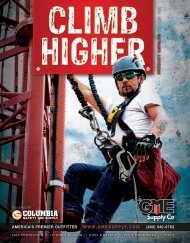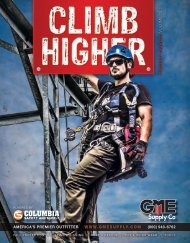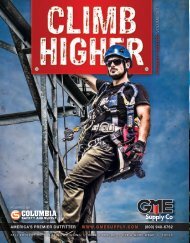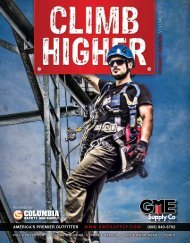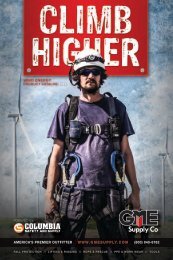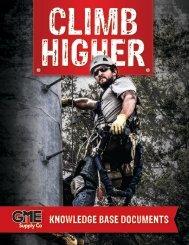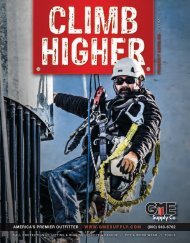GME Supply Catalog Version 19.4
GME Supply is North America's premier outfitter of fall protection, safety equipment, and gear for at-height workers, industry, and construction.
GME Supply is North America's premier outfitter of fall protection, safety equipment, and gear for at-height workers, industry, and construction.
Create successful ePaper yourself
Turn your PDF publications into a flip-book with our unique Google optimized e-Paper software.
WALKING WORKING SURFACES
1910 SUBPART D
From 2006 to 2012, there were an average of
261 fatal falls to a lower level annually in general
industry, not including falls in the construction
industry, resulting in over 48,379 lost-workday
injuries reported. Slips, trips, and falls on the same
level were reported in more than 125,000 injuries
a year.
This new standard overhaul allows employers more
flexibility in creating their fall protection solution for
what will work best in their situation like guardrails
and handrails, personal fall protection, designated
areas, and safety net systems. It also incorporates
technical information and guidelines from the
construction industry that were previously not
included in the general industry standards, such as
fall protection systems, rope descent systems, and
training on fall hazards and fall protection.
Below is a section by section breakdown of the
standard. For a full understanding, reference the
OSHA website.
STANDARDS BREAKDOWN
1910.21 - SCOPE & DEFINITIONS
OSHA is consistent with terminology used in
other general industry, construction, and maritime
standards to make the new requirements easier to
understand.
1910.22 - GENERAL REQUIREMENTS
Employers must now regularly inspect all walkingworking
surfaces for unsafe conditions and correct
or repair any problems quickly. If the repair cannot
be handled immediately the hazard must be
guarded to prevent access.
1910.23 - LADDERS
Existing requirements on portable and fixed
ladders have been combined. This section requires
that when ascending or descending a ladder,
employees must maintain 3 points of contact by
facing the ladder, using at least one hand at all
times, and not carrying any object or load that
could cause them to lose balance and fall.
While the provision will allow them as a temporary
solution, OSHA is ultimately phasing out cages and
wells on fixed ladders. Any existing ladders with
cages or wells will need to be modified with ladder
safety systems or a personal fall arrest system to
meet the new standard within the next 20 years.
98
GMESUPPLY.COM
1910.25 - STAIRWAYS
The term stairways now applies to all permanently
installed stairs regardless of step count. Spiral, ship,
and alternating tread-type stairs are only permitted
where standard stairs would not be practical.
1910.26 - DOCKBOARDS
Dockboards, or bridge plates must have edging or
curbing to prevent equipment from running off the
edge. This protects employees that may be working
below from dropped objects. Any transport vehicles
must also be prevented from moving on dockboards.
1910.27 - SCAFFOLDS & ROPE
DESCENT SYSTEMS
Employers must now comply with the construction
industry standards for scaffolding. There is also
new language for rope descent systems, which
were not previously regulated by OSHA.
1910.28 - FALL PROTECTION
A brand new section which allows employers
to choose from several fall protection options in
addition to guardrails. Safety net systems, personal
fall protection systems (travel restraint systems,
fall arrest systems, positioning systems, etc.) and
designated areas. Fall protection must be provided
at four feet for general industry.
1910.29 - FALL PROTECTION SYSTEMS
Fall protection systems should be permanently
installed when possible so that they are available
whenever potential exposure to fall hazards exist.
Personal protective equipment, including fall
protection, must be provided by the employer at no
cost to the employee.
1910.30 - TRAINING
Employees who use any type of fall protection
system or equipment must have proper training
and retraining that is developed and taught by
a qualified person. This is a completely new
requirement under Subpart D. Employees must
be able to recognize fall hazards, know what to do
about the hazards, and understand how to properly
use all equipment to do their job.
SUBPART 1 - 1910.140 - PERSONAL
PROTECTIVE EQUIPMENT
This new section to Subpart 1, which covers
PPE, covers criteria for fall protection equipment.
Specifically, it outlines selection, use,
testing, inspection, maintenance,
and training.
COMPLIANCE DATES
The majority of the new requirements
went into effect January 17, 2017. But
OSHA extended some dates to give
employers time to properly train, evaluate
their programs, and purchase any new
equipment required for compliance.
1910 SUBPART D TIME LINE
Compliance Date: May 17, 2017
1910.30(a) and (b): Deadline by which
employers must train employees on fall
protection equipment hazards.
Compliance Date: November 20, 2017
1910.27(b)(1): Certification of
anchorages.
Compliance Date: November 19, 2018
1910.28(b)(9)(i)(A): Deadline by which
employers must equip existing fixed
ladders with a cage, well, ladder safety
system, or personal fall arrest system.
Compliance Date: November 19, 2018
1910.28(b)(9)(i)(B): Deadline by which
employers must begin equipping new fixed
ladders with a ladder safety system or
personal fall arrest system.
Compliance Date: November 18, 2036
1910.28(b)(9)(i)(D): Deadline by which
all fixed ladders must be equipped with a
ladder safety system or personal fall arrest
system.










